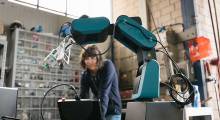Since ProMat 2011, the lift truck industry has been talking about the introduction of mass produced lift trucks that can operate as automatic guided vehicles (AGVs).
While there are a handful of implementations in New Zealand and Europe where lift trucks have been retrofitted to operate as AGVs, there haven’t been any examples in the US. At least there aren’t any that have been publicized.
That may be changing. At a recent press event, Toyota Material Handling U.S.A., Inc. (TMHU) showcased its latest contributions to the automatic guided vehicle (AGV) market.
This was a family affair of sorts. The event was held at Toyota Motor Manufacturing Kentucky, Inc. (TMMK), Toyota’s largest North American plant. The star of the show was the AutoGuide tugger model. For this application, TMHU bolted technology from AutoGuide onto a standard Toyota tugger, turning a conventional man-operated vehicle into a hybrid that can also operate as a completely autonomous AGV. In fact, 18 of the units have been in operation for the past five years. With an eight-month return on investment for each unit, the tugger units have helped TMMK improve safety, productivity and profits. What’s more, the units can be serviced by TMHU’s 220-location North American dealer network.
“It’s not just a product, it’s a solution,” says Jeff Rufener, president of TMHU.
The AutoGuide tugger was developed over the course of a ten-year relationship between TMHU, AutoGuide Systems, Industrial Concepts Incorporated, and TMMK. Paul Perry is the owner and CEO for AutoGuide Systems, a company specializing in automating lift trucks. Perry says the AutoGuide unit is unique in its ability to be easily attached or removed. Installation requires only six holes be drilled into the standard tugger, allowing customers to swap standard tuggers at the end of a lease term, for instance, while getting as many as 20 years of use out of the AutoGuide kit.
Once the AutoGuide unit is attached to a tugger, an operator can instantly convert it to manual mode simply by stepping on the pressure-sensitive mat. Additionally, the kit is made entirely with non-proprietary, off-the shelf parts, meaning customers will have little trouble ensuring the kit remains useful for many years to come.
“They say that non-proprietary parts will kill the AGV aftermarket business, but customers will choose standard industrial controls over proprietary black-box technologies every time,” says Perry. “Based on customer demand, we are directly addressing the cost, obsolescence and service support issues that have stymied the AGV industry. This solution is by the customer, for the customer.”
The kit is designed to easily interface with a facility’s existing PLC, WMS, AGVs, or AS/RS, using a familiar touch-screen Windows interface and a unique software called AVINU. Developed by ICI and the TMMK Bodyweld AGV Implementation Team, the Automated Vehicle Intersection Navigational Utility (AVINU), ensures the AGVs communicate simply and safely with the other equipment, employees and infrastructure at a facility.
In just one department at TMMK, the compressed footprint of AGV solutions have made room for 16 assembly lines where there once were 12, saving 317 days of manpower per year, including nearly 1,000 miles of walking distance. The body weld department currently attributes $1 million in annual savings to the AGV solutions. Furthermore, automated solutions have not resulted in a single layoff at the plant, where human resources have been directed away from repetitive tasks and toward value-added activities, according to Paul Stafford, specialist production engineering and AGV lead for TMMK.
TMHU is rolling out the tuggers in another Toyota auto assembly plant. Whether it can find a customer outside the Toyota family, or adapt the technology to a fork truck that is doing more than delivering to drop off and pick up locations, are yet to be seen. But it appears as if this is a step forward in that direction.







